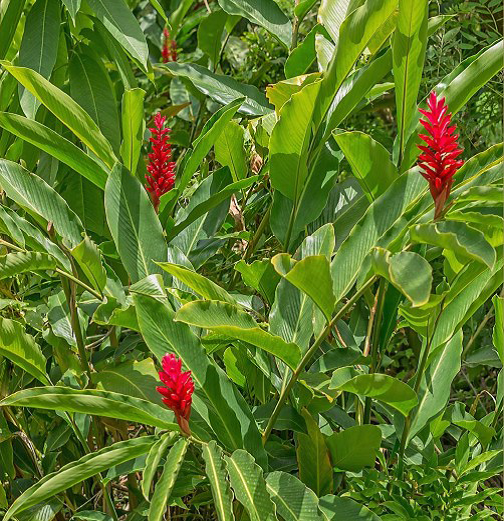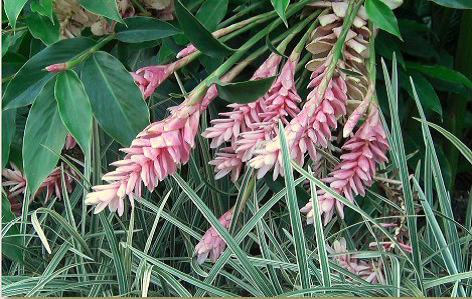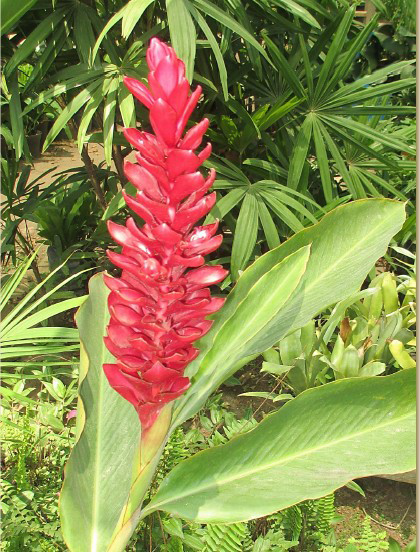By Tommy Clarkson from the November 2017 Edition
Red Ginger, Alpinia purpirata
Family: Zingiberaceae
Also known as: Ostrich Plume, Jungle King, Fire Ginger, Red Cone Ginger or Tahitian Ginger
Nellie Neal, who waxes almost poetically about our common botanical interests, writes in her book, a Gardener’s Guide to Tropical Plants, “Red Ginger is a romantic plant, conjuring up leafy tropical groves where fantastic flowers wait to be discovered among dense stands of leafy stalks . . . bringing the same allure to gardens worldwide.”
These great plants are often seen, amid other dense foliage, by tropical travelers racing hither and yon. But, unless purposeful attention is given them, they may not register in one’s consciousness in the here and now. They are splendid plants worthy of more attention than we sometimes take from our hectic, “helter skelter,” day-to-day existence. So, in this case, I suggest that, rather than “stop and smell the roses” you “pause and ponder the Ginger!”
The Ginger family, in its entirety, is comprised of over 200 species of perennial, clumping, Asian herbs. Virtually all are water lovers, enjoying full sun to partial shade, rich, well-draining soil and protection from strong winds. The fragrance of their blooms can best be enjoyed when the blossoms are bruised. Interestingly, the rhizomes, leaves and stalks are also aromatic. After flowering has run its course, cut the entire stalk down so as to encourage new cane growth.

Its colorful flower spikes are more than a foot (30 cm) long. Generally, they are among the earliest bloomers in the spring-time. The whitish flowers are actually quite tiny. Therefore, only the most patient of observers may really see the true flower which lies buried inside the brilliant bracts. It is those bold, bright, burgundy-red bracts – looking somewhat like the large, heads of maize (or, sometimes called milo) from my Kansas youth – that grab one’s attention.
Enjoying organically rich, well-draining soil in full sunlight, to that of a filtered shadowy nature, they are often found, naturally, on stream, river, and lake banks.

Commonly developing from the older inflorescences are multiple flower spikes and viviparous (meaning to produce seeds that germinate on its plantlets) offspring. Those seeds, by the way, are extremely small. So, actually, propagation can perhaps be accomplished best by root division.
They make wonderful container plants, colorful hedge screens or fillers. And if those weren’t in themselves good enough reasons to have some Red Ginger, the nectar of its flowers is attractive to bees, birds, and butterflies!
But, like so many plants, there is a degree of different opinions regarding Alpinia purpirata. For instance, while it’s the national flower of Samoa – known there as “teuila” – in Hawaii, it is considered an invasive species with some claiming that it is taking over the forests.
Other than, potentially, mealybugs, the Red Ginger has few natural enemies . . . well, unless you count those who come down, with shears in hand, in search of flowers for indoor vase display?
It is important to remember that they really appreciate high humidity. They are heavy drinking characters and require regular watering. They will love you to the bottom of their roots if you mulch two inches (5.08 cm) deep all around them. Even potted, do so to a depth of around one inch (2.54 cm). If taken care of, they will really spread rapidly.
Two very attractive cultivars are the ‘Tahitian Ginger’ whose plumes are often six inches (15.24 cm) in diameter and the ‘Jungle Queen’ which is a light-pink variety.

What with their attractive, deep-green leaves and multiple, brazenly, brilliant, bright bracts, these are nice to have. As Nellie correctly notes – once again from her book – its “dozens of rich, red, silky bracts shield tiny white flowers, creating a curvy cone of astounding color depth. The power of red as an attractant gives the bracts a sure lure for insect pollination, as effective as a bullfighter’s cape.”
For back issues of “Roots”, gardening tips, tropical plant book reviews and videos of numerous, highly unique eco/adventure/nature tours, as well as memorable “Ultimate Experiences” such as Tropical Garden Brunches.
Download the full edition or view it online
—
Tommy Clarkson is a bit of a renaissance man. He’s lived and worked in locales as disparate as the 1.2 square mile island of Kwajalein to war-torn Iraq, from aboard he and Patty’s boat berthed out of Sea Bright, NJ to Thailand, Germany, Hawaii and Viet Nam; He’s taught classes and courses on creative writing and mass communications from the elementary grades to graduate level; He’s spoken to a wide array of meetings, conferences and assemblages on topics as varied as Buddhism, strategic marketing and tropical plants; In the latter category he and Patty’s recently book, “The Civilized Jungle” – written for the lay gardener – has been heralded as “the best tropical plant book in the last ten years”; And, according to Trip Advisor, their spectacular tropical creation – Ola Brisa Gardens – is the “Number One Tour destination in Manzanillo”.



